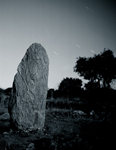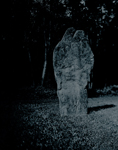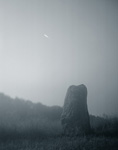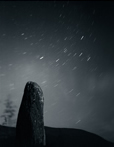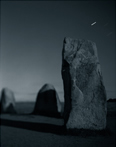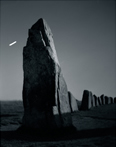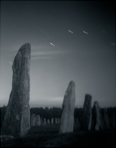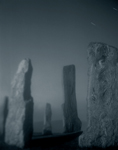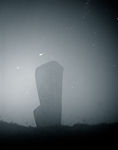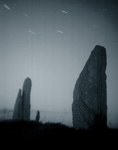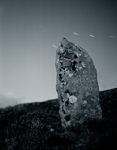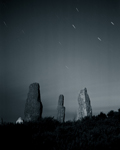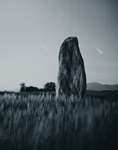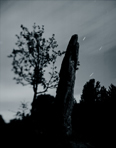 | 
In 2003 I pitched my tent next to the ancient Ring of Brodgar in Scotland and photographed from evening through the night until dawn. That was the beginning of this project, a series of images from Sweden to Armenia featuring various megalithic, standing stones. Also called menhirs, the earliest ones were erected around 3,650 to 2,500 years B.C. Although some of them have burial sites beneath them, and several were obviously used for astronomical observations, we really don't know much about who constructed them or why. This mystery is one of the things that draws me to them.
These ancient people were obviously spiritual and were aware of a power greater than themselves. They erected the stones so that they pointed to the heavens--the menhirs were definitely connectors between earth and sky. Many people theorize about stone circles and other formations being meeting places or grave markers, and the evidence is fairly conclusive that some were astral observatories. Perhaps they were all of these things. We simply do not know. I also believe that in this Age of Reason most theorists are overlooking the obvious--the stones are art. They are sculpture. These megalithic people selected the stones, and often transported them great distances, because of their shapes and textures. It must have taken a charismatic leader with a strong, clear vision to mobilize the tremendous communal effort it would have taken to erect these stones, some of them weighing several tons. That leader was probably an astronomer-priest and was definitely an artist.
The very act of human questing is romantic to me. Many of these stones are difficult to find and must almost be stumbled upon. Romance has an element of adventure to it, and adventure is going into the unknown. And being in the presence of a great work of art involves an element of romance that transports us to another place without time. As Barbara Lazear Ascher has written, "We are engaged in an ageless romance that binds us through the centuries to each person who has stood awed by the power of a hawk's precise dive or tree branches' upward stretch toward mystery. We, who stand in gathering darkness beneath spruce and oak, awaiting the black-outlined wings of an owl in flight, become part of this continuum." In this fashion, I have stood alone at night by an ancient stone circle, with a brilliant, starry sky overhead and the moon reflecting on a Scottish loch below me, the silence broken only by the sound of a cricket, and felt the wonder of humanity's connection with the cosmos and with whatever force it is that holds everything together. This is truly romance. Sigurd F. Olson says, "So responsive can we become, even the slightest movement of grasses, leaves, or insects is part of our awareness, until it seems we are hearing with our skin, our sight, smell, and touch, for these are part of the overall pervading silences of the past."
There is a timeless quality about these stones that gives them enormous power. As Angus Peter Campbell puts it, suddenly you realize that this stone you're gazing upon "...was here before you came, and it will be here after you have gone, receiving the warm west wind, bowing before the terrible winter storms, coping, thrawn, surviving."
A stone is that from which we come, is that to which we go back, it's the earth itself.
 Isamu Noguchi Isamu Noguchi
Photographing at night, with the stones against the night sky, emphasizes their shapes as well as the relationship between "figure and ground," between the focal object and its surroundings. The "star trails" add another element, that of time. They are a visual record of how much the earth has moved during the exposure, which can be 8 minutes or more than an hour. And the gravure process (the way the paper is pressed into the bitten plate) complements the texture of the stones.
The otherness of stones and stars, like that of wild animals, is their deepest mystery, for they are not our products and their purposes are their own. They are the models for thinking our humbleness in the universe, and they are the key to the strangeness of ourselves.
 Paul Shepard Paul Shepard
|



